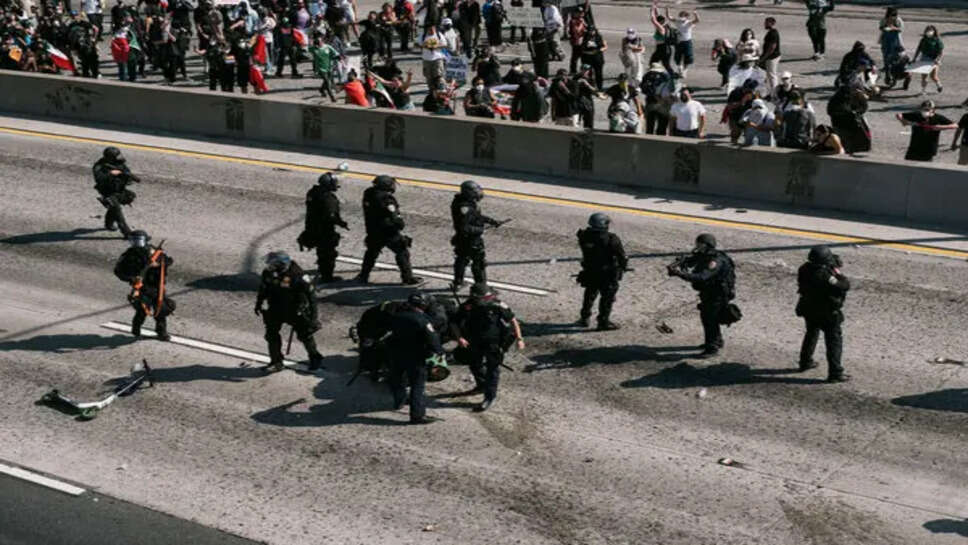LA Protests Escalate: US Marines to Hit the Streets in 48 Hours

Los Angeles is entering a critical juncture as state and city officials confirm that US Marines will be mobilized onto the streets within the next 48 hours. This extraordinary decision reflects a sharp escalation in response to dramatic civil unrest, widespread property damage, and an intensification of protest activity that has shaken the city for days.
📅 Timeline of Events
-
Day 1–3: Protests began in downtown L.A. following a police-involved shooting in South L.A. Demonstrations marked by peaceful marches in the mornings descended into heated clashes at night.
-
Days 4–5: Violence escalated. Vandals looted shops and luxury storefronts in West Hollywood and Beverly Hills. Vehicles were overturned. Night curfews were announced, but enforcement faltered amid the chaos.
-
Day 6: Despite heavy police deployment, fires burned, buildings were broken into, and officers came under attack with rocks, bottles, and fireworks. In response, the mayor activated the National Guard earlier than anticipated.
-
Day 7: With unrest showing no signs of abating, National Guard units began deploying across key hotspots. Still, the looting and confrontations continued.
-
Now, Day 8 and counting: Escalation from Guardsmen to Marines was announced—marking the first use of US Marines on Los Angeles streets in decades.
⚔️ Why Deploy the Marines?
The decision follows several key criteria:
-
Sustained public disorder despite police and Guard presence.
-
Rising civilian and officer casualties, with dozens injured and hospitals reporting serious trauma cases.
-
Escalating property destruction and economic losses in entertainment districts, small businesses, and major shopping areas.
-
An official request from California’s governor to the Pentagon, citing imminent loss of control over critical infrastructure.
-
A rationale that Marine deployment brings tactical proficiency for urban operations, offering greater discipline and resources than state Guard forces.
Onlookers suggest the move aims to restore order and deter further violence—though critics raised alarms over the use of military personnel against civilians on U.S. soil.
🎯 Mission and Rules of Engagement
The Marines are expected to deploy under what is known as Title 32 status, operating under state—not federal—authority. Initial deployment will include:
-
1,200–1,500 personnel drawn from nearby Marine Air Ground Task Force units.
-
Deployment zones extending through downtown, West Hollywood, and Venice Beach, with a focus on chaotic locations.
-
A supporting role: guarding key infrastructure—police stations, jails, museums, transit hubs—while assisting National Guard and city police.
-
Rules of Engagement: Marines will not initiate crowd control actions. Instead, they will hold static posts, protect high-value assets, and provide backup. Any active interventions will be led and coordinated by local law enforcement.
👥 Reactions Across the Board
Officials
-
Mayor’s office described the measure as “necessary, firm but temporary” and sought to reassure the public of safety and constitutional rights.
-
California Governor emphasized protecting civilians and assets while citing the escalation of threats as justification.
-
The White House noted support for the governor’s decision but emphasized that deployment rests with local authority.
Police and Union Groups
-
A local Police Benevolent Association welcomed the reinforcement, calling it "long overdue." Officers described being spread thin, outnumbered at hotspots, and unable to clear rioters efficiently.
-
However, some officers voiced caution: “We can’t rely on Marines to replace community policing.”
Civil Liberties Watchdogs
-
Concern emerged from groups like the ACLU, calling the move “a dangerous precedent,” warning of risks to peaceful protesters.
-
Community organizations demanded clarity on how Marines would interact with civilians and guaranteed rights to assemble lawfully.
🌆 What Happens Next?
Curfews and Zoning
-
Curfew times are expected to extend—from early evening to midday—to accommodate Marine presence.
-
Certain districts—like Fairfax, Melrose, or Hollywood—may be closed entirely to traffic or pedestrian movement under temporary restricted zones.
Community Protests
-
Activist leaders already planning a “Protector March,” stating peaceful assembly will continue.
-
Organizers vow to comply with curfew rules and city permits, countering narratives of civilian antagonism.
Guard–Police Integration
-
Command centers involving local and state officials will coordinate unit positioning and rules of engagement.
-
Provisions are being deployed to avoid accidental escalations and ensure de-escalation training for troops.
Media Spotlight
-
Both domestic and international press are now focusing on L.A. Scenes from protests, destruction, and military presence are dominating global broadcasts, testing the city’s image as a tolerant, creative epicenter of America.
🧭 Broader Risks and Concerns
-
Public Trust
The deployment of Marines—while tactical—risks alienating protestors, raising fears of militarization of police response, and hurting the city’s long-term trust fabric. -
Legal Review
Civil rights groups prepared to challenge the deployment order in court, questioning whether such measures have clear legal merit and constitutional grounding. -
Economic Fallout
Hardened storefronts and roadblocks may prolong closures and delay business recovery. Tourism warnings have already been issued. -
Escalation Potential
Critics worry about how tension might escalate with more aggressive military involvement, leading to higher potential for clashes between troops and civilians.
🛠️ Recovery and Return to Normality
-
Timeline: Officials indicate a 2–3 week deployment, contingent on restoring calm.
-
Economic Reverse: Government programs are being planned to help affected businesses with grants, insurance claims, and rehabilitation.
-
Comprehensive Review: Post-deployment, there will likely be a full examination of decisions, protocols, and feedback from agencies, watchdogs, and community leaders.
📝 Final Word
Los Angeles now stands at a pivotal moment. What began as local protests has intensified into city-wide unrest, prompting extraordinary measures—like the deployment of US Marines—to support overwhelmed local forces. For residents, it is a time of severe disruption and uncertainty. For authorities, it is a test of balancing stability with civil liberties and moving forward amid national and global scrutiny.
The coming days will define whether this “all-hands” intervention restores peace or risks deeper fractures. L.A. has weathered turbulence before, but the presence of troops on its streets signals how high the stakes are now—and how much work lies ahead to heal and rebuild.
.jpg)